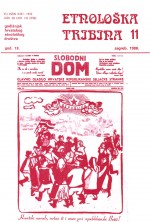Etnologija između demografije i socijalne historije
Ethnology Between Demography and Social History
Author(s): Jasna ČapoSubject(s): Social history, Cultural Anthropology / Ethnology, Demography and human biology, Rural and urban sociology
Published by: Hrvatsko etnološko društvo
Keywords: ethnology; demography; social history; village; everyday life;
Summary/Abstract: The author discusses the interrelationship between ethnology, demography and social history. The underlying hypothesis is that differences between the three disciplines are historically conditioned by the institutionalization of these disciplines. Differences, especially those between history and ethnology, fade away on the epistemological level. By pointing to the basic similarity and commonality of interests between the three disciplines in the intellectual sense, the aim of the text is to propose some methodologically relevant points for an interdisciplinary approach to studying everyday life in a village. In the first part the author recapitulates the interest of ethnology for historical context. The utility of incorporating historical dimension in ethnological studies is twofold. First, by taking into account the impact of historical circumstances (political, economic, demographic, institutional, ideological) on social and cultural systems, the student realizes that his/her subject matter is not on eternal, fixed and never-changing structures. At the same time the historical dimension inspires the study of the construction of social and cultural life, viz. the diahrony. On the other hand, history turned to ethnology when it underwent a change in its subject matter — a change from narration of events to styding the everyday life of common people. In the third part, the author discuses the relationship between demography, notably historical demography and ethnology. The author proposes that demography studies the underlying bases of social and cultural life. In that sense it is an auxiliary discipline of every social and humanistic science. Among its other contributions, the demographic approach in ethnology enables the delineation of socioeconomic groups within a society and the study of ordre vecu rather that of order concu of social life. In the end, the author proposes a distinction between ethnology and historical ethnology. The second would simply be ethnology transposed into the past, the materials of which are beyond reach of the memory of living beings. In this sense it could also be called social history or histoire des mentalites.
Journal: Etnološka tribina : Godišnjak Hrvatskog etnološkog društva
- Issue Year: 18/1988
- Issue No: 11
- Page Range: 5-16
- Page Count: 12
- Language: Croatian

